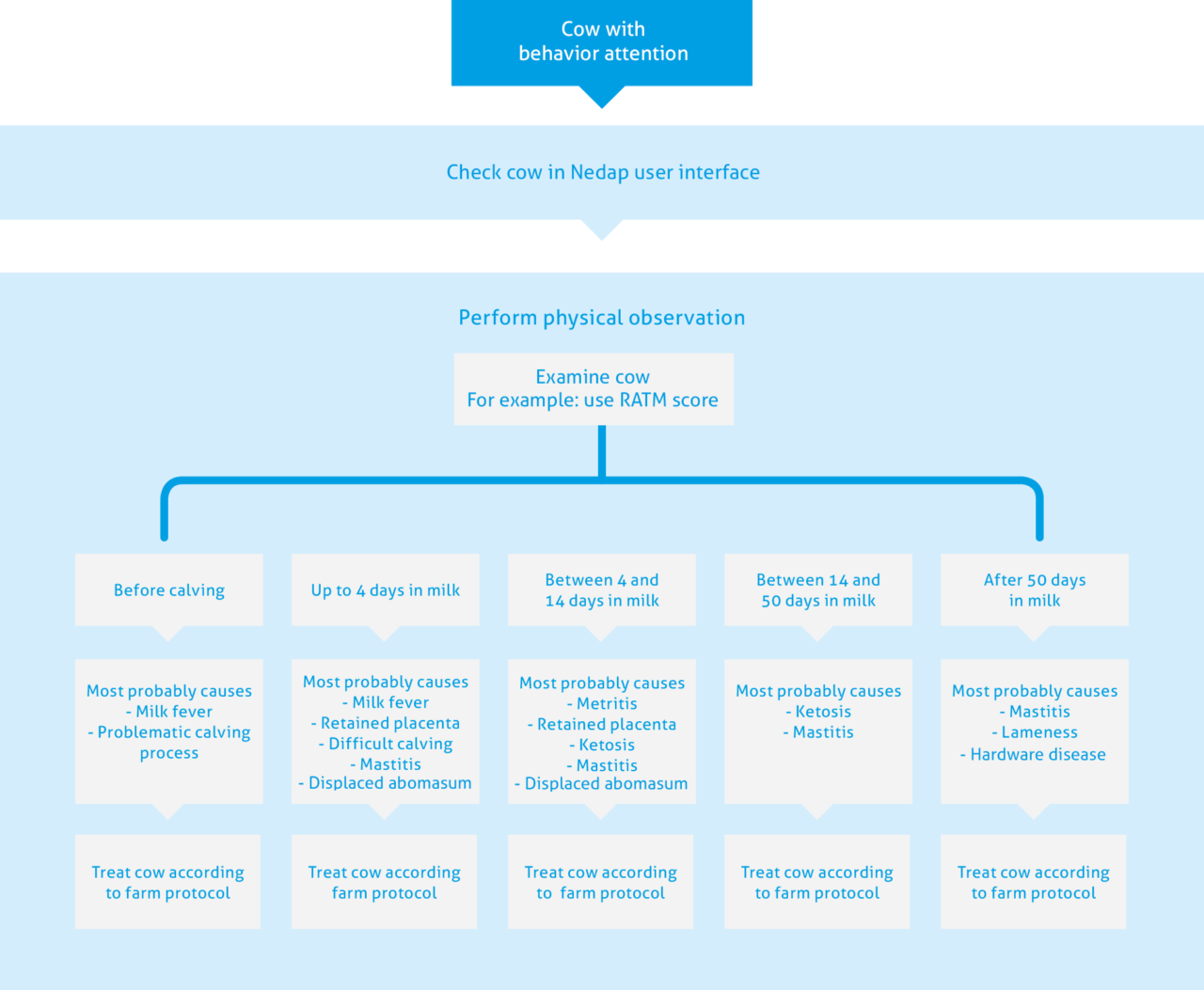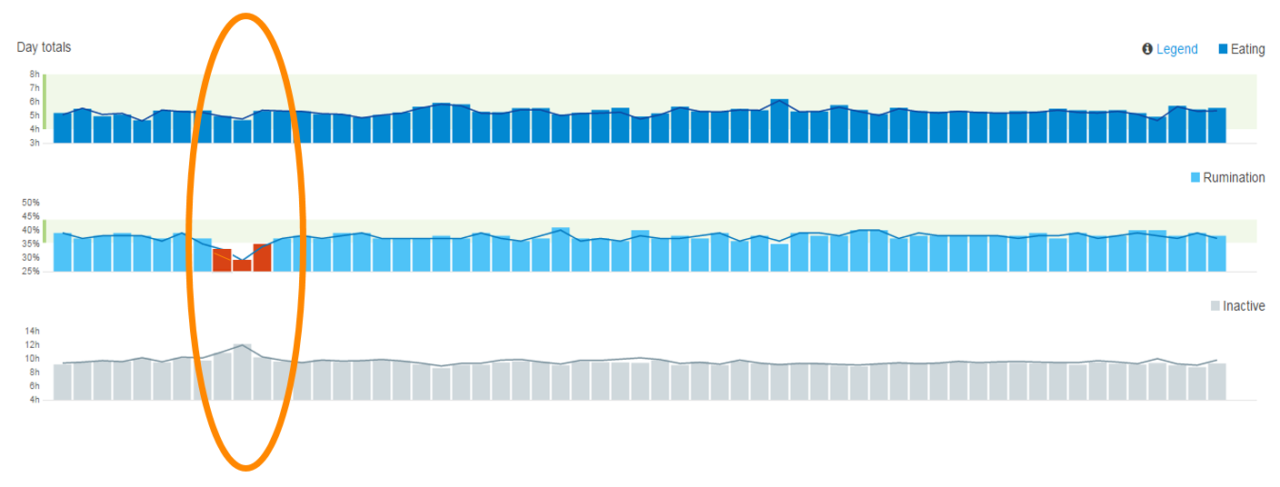
Using Vigreen COWControl on a day-to-day level
Cows on a dairy farm can deliver peak performance daily. Every day, a cow can produce about 10% of her bodyweight in milk. To deliver that level of performance, cows must be in top condition, which is the responsibility of every dairy farmer/herd manager. Vigreen COWControl provides information about the behavior of dairy cows. The dairy farmer or herd manager can then use that information to carry out his or her tasks, and those of their staff, more effectively and efficiently.
Urgent intervention
Many activities performed on a dairy farm are tasks and protocols carried out daily. Incidental tasks aside, urgent matters may arise that require immediate intervention by the dairy farmer or herd manager. The health of the herd is one important example. Vigreen COWControl measures a unique number and combination of aspects of cow behavior. If a cow suddenly stops eating, ruminating or displaying any other type of active behavior, this is (almost) always an indication of an issue relating to that cow. In such situations, Vigreen COWControl sends an urgent alert to the dairy farmer or herd manager. He or she can then take immediate action based on the alert received. Research has demonstrated that the alerts issued by the system are both accurate and effective.

The possible reasons why a cow suddenly stops eating and/or ruminating:
- Coli mastitis
- Milk fever
- Acute ketosis
- Hardware disease
- Lameness
- Displaced abomasum

Farm protocols
In addition to a well-organized process, successful daily use of sensors requires excellent sensors and detection of algorithms. The dairy farmer or herd manager must be aware of what should be done whenever an issue occurs. He or she also needs to have access to all the relevant information and tools needed to make and implement decisions at the practical level. The overall picture is what counts and matters. Setting up and using clear farm protocols is important for the farmer or herd manager and the staff to know what action should be taken in case of a particular alert. It maximizes the benefits of the system.

System design must be based on the optimum interaction between the dairy farmer or herd manager and the system itself. This article provides sample protocols for the types of decisions that can be made at each level. The dairy farmer or herd manager can utilize these within his or her own operational processes

Support during daily work
In addition to issuing alerts for urgent attention, Vigreen COWControl also helps dairy farmers or herd managers perform recurring management tasks.
Risk group – recently calved cows
Recently calved cows form a risk group. During this transitional period between calving and producing large quantities of milk, cows are more vulnerable to bacteria and diseases. Ensuring lactation is off to a good and healthy start will enable cows to remain productive longer and produce higher yields. This yield continues even during subsequent lactations. Monitoring the behavior of recently calved cows enables dairy farmers or herd managers to identify
which cows need extra attention during this risky transition period. A decrease in the time spent eating and ruminating around calving time is acceptable, but that drop must not continue for too long. After calving, an increase in eating time must take place to meet the energy requirements of the cow. Too little time spent eating and ruminating may indicate health problems relating to calving, such as milk fever, dystocia or difficult calving, retained placenta or mastitis.

The Vigreen COWControl system provides the dairy farmer or herd manager and his or her employees with valuable information regarding critical factors determining rumen health. It also provides information about the effective distribution of feed intake throughout the day and the extent to which an individual cow or the entire group is ruminating, meaning the health of the rumen can be monitored on a continuous basis. And the farmer can act at an early stage to prevent potential problems.


Post-treatment recovery
Any observation of a cow is simply a snapshot. It does not provide any information about what the cow was doing before the observation was made. That is why post-treatment checks are a difficult task. If some cows in a group received treatment, it is difficult to monitor the feed intake and rumination of each cow. It is impossible to see whether a cow that received treatment is eating and ruminating sufficiently.
Continuous monitoring with the support of sensors helps the dairy farmer or herd manager monitor whether a treatment has been effective or not effective. For example, if a cow has been treated for a displaced abomasum, monitoring to ensure sufficient rumination is preformed is an important indicator of recovery. Adequate eating and rumination is also an important indicator of recovery from other health issues.
Vigreen COWControl enables dairy farmers and herd managers to monitor the information that the system provides during the week before calving and for two weeks after calving. Cows showing any change in eating behavior and rumination pattern can then undergo an additional clinical examination to stay one step ahead of additional serious problems.


It is recommended that the dairy farmer or herd manager integrates the sample procedure below to their farm protocols.

Protocol – A cow is the subject of an animal behavior alert. RATM score is attached on page 19.
Operational information regarding a group
The system provides operational information relating to individual cows and the group. An example of operational information on group level: a decrease in feed intake due to an employee failing to make the feed available or a decrease of eating and rumination because cows were locked at a feed bunk and standing for too long.

Example of a group overview showing a decrease in feed intake due to a mistake by an employee.

